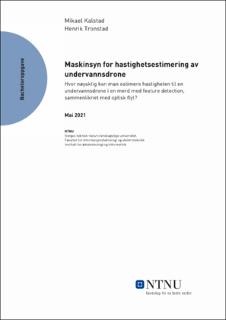| dc.contributor.advisor | Jørgensen, Jonathan | |
| dc.contributor.author | Kalstad, Mikael | |
| dc.contributor.author | Tronstad, Henrik | |
| dc.date.accessioned | 2021-09-15T16:46:40Z | |
| dc.date.available | 2021-09-15T16:46:40Z | |
| dc.date.issued | 2021 | |
| dc.identifier | no.ntnu:inspera:83510435:83529094 | |
| dc.identifier.uri | https://hdl.handle.net/11250/2778043 | |
| dc.description.abstract | I dette prosjektet har vi forsket på to ulike maskinsyns-algoritmer for hastighetsestimering av en undervannsdrone. Løsningene er produsert for SINTEF Ocean AS, hvor de skal brukes på en undervannsdrone som beveger seg langs et nettet i en merd. Vi har eksperimentert med flere ulike
algoritmer, men vi valgte å forske på feature matching og optical flow. Fokuset i dette prosjektet var å sammenligne nøyaktigheten til feature matching og optical flow for hastighetsestimering av en undervannsdrone i en merd.
På grunnlag av dette kom vi fram til vår problemstilling: Hvor nøyaktig kan man estimere hastigheten til en undervannsdrone i en merd, ved bruk av feature matching sammenliknet med
optical flow?
Det eneste av input til algoritmene er video-data fra undervannsdronen. Video-ressursene vi har brukt til testing, besto av både simulerte nett og opptak fra en reell merd. En utfordring er at nettet er visuelt uniformt. Dette gjør det vanskelig å behandle video-data, og beregne bevegelsen
til undervannsdronen.
Resultatet etter testing og forskning viser at begge algoritmene er uegnet til praktisk bruk. Til tross for dette, er fortsatt feature matching mer nøyaktig enn optical flow ved høyere hastigheter i det simulerte miljøet. Optical flow er derimot mer nøyaktighet enn feature matching ved lavere hastigheter i simulert miljø. Feature matching er mer nøyaktig enn optical flow ved alle
hastigheter for video-data fra en reell merd. Algoritmene gir forskjellige resultater, men generelt er ingen av de egnet til praktisk bruk. | |
| dc.description.abstract | In this project we have researched machine-vision algorithms for velocity estimation of an underwater drone. The solutions are produced for SINTEF Ocean AS, where they will be used in an underwater drone that moves along a fish net. We have experimented using multiple different algorithms, but the focus in this report is on feature matching and optical flow. Furthermore we will focus on comparing the accuracy of feature detection and optical flow for velocity estimation of an underwater drone in a fish net.
On the basis of this, we decided our thesis question: How accurately can one estimate the velocity of an underwater drone in a fish net, using feature matching compared to optical flow?
The only input for the algorithms is video from the underwater drone. The video resources we have used for testing consisted of both a simulated and a real fish net. The fish net is visually uniform, which is a challenge which makes it difficult to work with the video data and estimate the velocity.
The results show, after testing and research, that neither of the algorithms are suitable for use in practice. In the simulated environment, feature matching is more accurate than optical flow during higher velocities. Optical flow is more accurate during lower velocities. In the real video, feature matching has a higher accuracy during every velocity compared to optical flow. The algorithms gave different results, but generally neither are suitable for use in practice. | |
| dc.language | nob | |
| dc.publisher | NTNU | |
| dc.title | Maskinsyn for hastighetsestimering av undervannsdrone | |
| dc.type | Bachelor thesis | |
